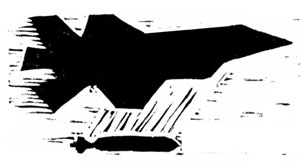Tom Boswell: Fighter jets are useless against pandemics, natural disasters
The Cap Times Apr 18, 2020
Read online
 For well over a year now, the local Air National Guard unit, in tandem with the Chamber of Commerce and Sen. Tammy Baldwin, has been spreading a false narrative about the future of Truax Field. The message is that if they fail to get their fancy new death machine — the F-35 — the base will close. The reality is that the Air Force has never said that closing the base is an option.
For well over a year now, the local Air National Guard unit, in tandem with the Chamber of Commerce and Sen. Tammy Baldwin, has been spreading a false narrative about the future of Truax Field. The message is that if they fail to get their fancy new death machine — the F-35 — the base will close. The reality is that the Air Force has never said that closing the base is an option.
In fact, there is a much better option than the F-35 or nothing. Rather than chasing after the latest fighter jet to come along, Truax Field officials could request a new mission. Now, while we face a major health crisis, would be an opportune time for the Guard, the Chamber and Baldwin to show that they really have the health and welfare of our community at heart. (Forgive us if we are a little skeptical after a half-century of the contamination of our water and no substantial efforts to mitigate the noise problem).
There are a multitude of missions for Air or Army Guard units to choose from and now would be the best time to consider what type of mission would best serve our community’s interests. With the current COVID-19 pandemic in mind, it seems prudent to consider a mission that could combat future health emergencies and/or natural disasters, both of which we are likely to face more of in coming years.
National Guard units are playing a major role in fighting the current crisis. In New York, California and other states hit hard by the pandemic, the Guard is busy: supporting local emergency agencies with response planning and execution; providing critical Personal Protective Equipment training; staffing call centers; providing transportation support for health care professionals; distributing food and medical supplies and assisting at food banks; helping collect test samples at drive-thru testing sites; cleaning public spaces, and a myriad of other important tasks.
“I believe the fight against COVID-19 will exceed what we did in response to the attacks of 11 September 2001 and our response to Super Storm Sandy,” said Army Maj. Gen. Ray Shields, the adjutant general of New York. “This is that serious.”
Hurricane Katrina resulted in the largest ANG mobilization ever for a domestic emergency. Every type of airlift aircraft assigned to the Air Guard was used, including the Lockheed Martin C-130 transport plane and other Lockheed and Boeing aircraft. An Aeromedical Evacuation Squadron flew medevac missions, administered vaccinations and distributed water, food and health education materials.
The Guard’s Expeditionary Medical Support (EMEDS), a modern version of the Mobil Army Surgical Hospital (MASH), was used for the first time in a U.S. natural disaster. Over 1,000 Air Guard medical personnel deployed to the Gulf region in response to hurricanes Katrina and Rita and over 30,000 victims received medical treatment from the EMEDS system.
The non-flying missions actually accounted for the largest portion of the Air Guard’s contribution to the hurricane relief effort. ANG personnel represented medical, security, civil engineering, intelligence, communications and supply specialties.
Our comrade in peace, retired Air Force Col. Rosanne Greco, notes that various other Guard bases have changed their missions. The Air Guard base in Great Falls, Montana switched from F-15 fighter aircraft to C-130s in 2016. The New Mexico ANG changed from a fighter mission to training crews in special operations and personnel recovery in 2013. She cites an article in the Air Force Times that the demand for mobility aircraft — transports, cargo and refueling — is increasing.
Yes, there can be life after a fighter jet mission, and probably a lot more life here and abroad once we trade in bombers for a medical and/or disaster relief mission. Truax Air Guard base can then become a much more valuable asset to our community, most likely providing more jobs than the current fighter aircraft mission, and more compatible with Madison’s progressive values.
Tom Boswell is a community organizer with Safe Skies Clean Water Wisconsin.
